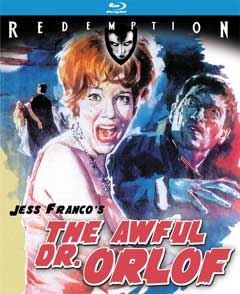 THE
AWFUL DR. ORLOF (1962) Blu-ray
THE
AWFUL DR. ORLOF (1962) Blu-rayDirector: Jess Franco
Redemption Films/Kino Lorber
 THE
AWFUL DR. ORLOF (1962) Blu-ray
THE
AWFUL DR. ORLOF (1962) Blu-rayThe film that put Jess Franco (and Howard Vernon) on the international horror map, THE AWFUL DR. ORLOF makes its high definition bow courtesy of Redemption Films’ Blu-ray.
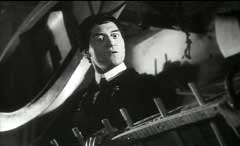
Showgirls in a German city are disappearing into the night, and the witnesses offer up conflicting descriptions to detective Tanner (Conrado San Martin, EDGE OF THE AXE), but he’s more interested in wooing ballerina Wanda Bronski (Diana Lorys, THE HOUSE OF PSYCHOTIC WOMEN). The culprit is former prison doctor Dr. Orlof (Howard Vernon, A VIRGIN AMONG THE LIVING DEAD) who – with his blind “oral sadist” henchman Morpho (Ricardo Valle, SUMMERTIME KILLER) and reluctant mistress Arne (Perla Cristal, FURY OF THE WOLFMAN) – is nabbing girls easily taken in by baubles as unwilling skin donors to restore the beauty of his daughter Melissa (also Diana Lorys) scarred in a lab fire. As more women disappear, Tanner does not know what to make of the conflicting descriptions (even after a group session with a sketch artist narrows it down to two distinct likenesses), and he dismisses Wanda’s claim to have encountered one of the men. As Tanner looks into the recovery of the expensive necklace worn by one of the victims which has been pawned by sketchy Jeannot (Faustino Cornejo), Wanda plays amateur sleuth and decks herself out in a “harlot dress” to catch the eye of Dr. Orlof at a local cabaret (which is fortunate since Orlof has decided her physical resemblance to his daughter makes her the ideal surgical candidate).
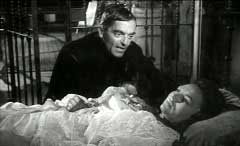 Known
as GRITOS EN LA NOCHE in Spain, THE AWFUL DR. ORLOF is the genesis point of
the many characters and story elements that would pervade the director’s
work for the next fifty years. The surgical horror element of the plot surely
owes much to EYES WITHOUT A FACE (although Franco has always denied familiarity
with the film at the time he shot ORLOF), but Video Watchdog’s Tim Lucas
has also pointed out similarities to the film adaptations of Edgar Wallace’s
novel “The Dark Eyes of London” (especially Alfred Vohrer’s
1961 adaptation THE DEAD EYES OF LONDON), particularly Morpho’s similarity
to the novel’s henchman “Blind Jack”. When asked about the
film, Franco has been quoted as saying he regards ORLOF as a museum piece; and
– despite the instances of taboo-breaking nudity exclusive to the French
version – a large part of the appeal of watching Orlof again is seeing
Franco’s formal handling of gothic horror elements in contrast to what
were his more widely distributed works in the earlier age of video before the
long-referenced AWFUL DR. ORLOF became more accessible to English-speaking viewers.
Known
as GRITOS EN LA NOCHE in Spain, THE AWFUL DR. ORLOF is the genesis point of
the many characters and story elements that would pervade the director’s
work for the next fifty years. The surgical horror element of the plot surely
owes much to EYES WITHOUT A FACE (although Franco has always denied familiarity
with the film at the time he shot ORLOF), but Video Watchdog’s Tim Lucas
has also pointed out similarities to the film adaptations of Edgar Wallace’s
novel “The Dark Eyes of London” (especially Alfred Vohrer’s
1961 adaptation THE DEAD EYES OF LONDON), particularly Morpho’s similarity
to the novel’s henchman “Blind Jack”. When asked about the
film, Franco has been quoted as saying he regards ORLOF as a museum piece; and
– despite the instances of taboo-breaking nudity exclusive to the French
version – a large part of the appeal of watching Orlof again is seeing
Franco’s formal handling of gothic horror elements in contrast to what
were his more widely distributed works in the earlier age of video before the
long-referenced AWFUL DR. ORLOF became more accessible to English-speaking viewers.
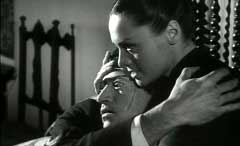
Godofredo Pacheco’s monochrome cinematography looks incredibly elegant for viewers accustomed to Franco’s later works, particularly a stunning reveal of Vernon’s face in the first night club scene (although his other early B&W works like DR. ORLOFF’S MONSTER and DIABOLICL DR. Z are similarly slick as are some of Franco’s lesser-seen Spanish works from the 1980s), contributing so heavily to the period look that the experimental score of José Pagán and Antonio Ramírez Ángel (THE DRACULA SAGA) doesn’t clash as heavily with the atmosphere as one would expect. Not exactly an unknown at the time of the film’s production, Vernon (first-billed in the French version but third behind San Martin and Lorys in the Spanish cut) nevertheless hits it out of the park in his first of roughly forty Franco collaborations, and Lorys – as if realizing that she would be dubbed in likely even the Spanish version as well as the French and English versions – impresses with a performance that relies more on facial expressions and eye movements than delivery of dialogue (check her out during the scene with Vernon in one of the night club’s private rooms). Among the victims is Maria Silva who would get more notable roles in later more permissive Spanish horrors TOMBS OF THE BLIND DEAD, CURSE OF THE DEVIL and THE MUMMY’S REVENGE, and American ex-patriot actor Frank Wolff (THE LICKERISH QUARTET) dubs Jeannot.
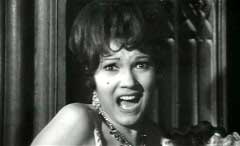 The
original Spanish version ran roughly ten minutes longer than the French version
seen here (86:35). Eurocine removed several extended bits of dialogue, shaved
several additional second off San Martin’s screen time in various scenes,
and pruned down the sketch artist sequence. The Spanish version also had significantly
more cast and technical crew listed, while the French credits suggest that the
comparatively ambitious film could have been achieved on one of the skeleton
crews of Franco’s later works from the 1970s onwards. They also added
two nude inserts which would not have been allowed in the Spanish version. The
inserts are not well-integrated even though they were shot on set. The first
features Orlof operating on the victim played by Mara Laso (NIGHT OF THE EXECUTIONER).
The Spanish version has … while the French version has her face covered
and her torso exposed as he makes an incision between her breasts (a subsequent
shot has her torso covered and half the skin of her face missing). The second
insert comes when Morpho catches an escaped Wanda and tears her dress and gropes
her (body doubled) breasts. Of course, subsequent shots show her dress undamaged.
Video Watchdog’s Tim Lucas goes into more detail in the commentary track.
The
original Spanish version ran roughly ten minutes longer than the French version
seen here (86:35). Eurocine removed several extended bits of dialogue, shaved
several additional second off San Martin’s screen time in various scenes,
and pruned down the sketch artist sequence. The Spanish version also had significantly
more cast and technical crew listed, while the French credits suggest that the
comparatively ambitious film could have been achieved on one of the skeleton
crews of Franco’s later works from the 1970s onwards. They also added
two nude inserts which would not have been allowed in the Spanish version. The
inserts are not well-integrated even though they were shot on set. The first
features Orlof operating on the victim played by Mara Laso (NIGHT OF THE EXECUTIONER).
The Spanish version has … while the French version has her face covered
and her torso exposed as he makes an incision between her breasts (a subsequent
shot has her torso covered and half the skin of her face missing). The second
insert comes when Morpho catches an escaped Wanda and tears her dress and gropes
her (body doubled) breasts. Of course, subsequent shots show her dress undamaged.
Video Watchdog’s Tim Lucas goes into more detail in the commentary track.
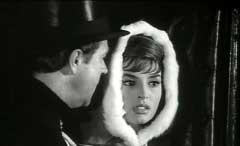
After its domestic theatrical release through Sigma III – sometimes on a double bill with Riccardo Freda’s THE HORRIBLE DR. HICHCOCK, and sometimes in an "Adults Only" variant with nude inserts (see below) titled THE HORRIBLE DR. ORLOF – THE AWFUL DR. ORLOF disappeared from circulation with apparently no television play and definitely no official video releases. Most American video era Franco fans would get their first sighting of ORLOF on video courtesy of the bits that Eurocine edited into their recut version of Franco’s REVENGE IN THE HOUSE OF USHER as “flashbacks” to Usher’s youth (additional scenes were shot with Olivier Mathot as an older version of Morpho and Francoise Blanchard as Usher’s daughter Melissa). The film itself would finally become available on the grey market in transfers of the standard cut through Something Weird Video – volume one of their “Sexy Shockers” line (they reportedly also planned to release the version with the nude inserts but that never happened) – and Sinister Cinema, as well as a SECAM-NTSC conversion of the French version with added English subtitles courtesy of Video Search of Miami.
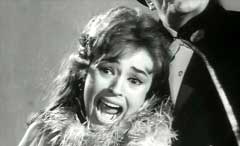 Eurocine
provided a beautiful letterboxed (1.66:1) albeit non-anamorphic and PAL-converted
transfer of the French version in 2000 for Image Entertainment’s “Euroshock
Collection” DVD – in a snapper case and a later Amaray release –
and VHS releases (the DVD later popped up as part of the boxed set “The
Orloff Collection” with Franco’s DR. ORLOFF’S MONSTER, Pierre
Chevalier’s ORLOFF AND THE INVISIBLE MAN (previously released here on
tape by Wizard as THE INVISIBLE DEAD), and the aforementioned REVENGE IN THE
HOUSE OF USHER). As with the earlier Franco Euroshock titles, no English subtitles
were provided for the French track, but the image was a nice step up from the
tape releases (although the SWV edition looked quite good for its time as it
came from the American negative). Whereas the Image transfer revealed more gloss,
Redemption’s 1080p24 MPEG-4 AVC-encoded widescreen (1.66:1) transfer reveals
more rough edges (on the commentary track, Video Watchdog’s Tim Lucas
points out more than a few camera shadows that went previously unnoticed). Gone
is the silvery black and white of the DVD, and in its place is a film that looks
much older than a 1960s film (and only in part due to Pacheco’s expressionist
photography). Contrast is a bit lighter than the DVD, which does make Vernon’s
shadowed face a bit more discernible in the night club scene before the light
reflecting off Dany’s compact mirror, but it doesn’t really shatter
the mood of the suspense sequences (although camera shadows pointed out by Tim
Lucas on the commentary track are now that much more evident). Presumably due
to the limitations of the original photography, some exterior night scenes look
murky outside of the lit areas while the interiors delineation of light and
shadow looks more expressionistic. Whether due to the cheap processing or the
preservation of the elements, some parts of the film look quite dirty –
although really no more so than some of Redemption’s other HD transfers,
it’s just more noticeable given the perhaps faulty impressions of how
watching the earlier DVD transfer was like experiencing the film completely
anew – compared to the bulk of the transfer which just looks “unrestored”
compared to studio pics of this vintage.
Eurocine
provided a beautiful letterboxed (1.66:1) albeit non-anamorphic and PAL-converted
transfer of the French version in 2000 for Image Entertainment’s “Euroshock
Collection” DVD – in a snapper case and a later Amaray release –
and VHS releases (the DVD later popped up as part of the boxed set “The
Orloff Collection” with Franco’s DR. ORLOFF’S MONSTER, Pierre
Chevalier’s ORLOFF AND THE INVISIBLE MAN (previously released here on
tape by Wizard as THE INVISIBLE DEAD), and the aforementioned REVENGE IN THE
HOUSE OF USHER). As with the earlier Franco Euroshock titles, no English subtitles
were provided for the French track, but the image was a nice step up from the
tape releases (although the SWV edition looked quite good for its time as it
came from the American negative). Whereas the Image transfer revealed more gloss,
Redemption’s 1080p24 MPEG-4 AVC-encoded widescreen (1.66:1) transfer reveals
more rough edges (on the commentary track, Video Watchdog’s Tim Lucas
points out more than a few camera shadows that went previously unnoticed). Gone
is the silvery black and white of the DVD, and in its place is a film that looks
much older than a 1960s film (and only in part due to Pacheco’s expressionist
photography). Contrast is a bit lighter than the DVD, which does make Vernon’s
shadowed face a bit more discernible in the night club scene before the light
reflecting off Dany’s compact mirror, but it doesn’t really shatter
the mood of the suspense sequences (although camera shadows pointed out by Tim
Lucas on the commentary track are now that much more evident). Presumably due
to the limitations of the original photography, some exterior night scenes look
murky outside of the lit areas while the interiors delineation of light and
shadow looks more expressionistic. Whether due to the cheap processing or the
preservation of the elements, some parts of the film look quite dirty –
although really no more so than some of Redemption’s other HD transfers,
it’s just more noticeable given the perhaps faulty impressions of how
watching the earlier DVD transfer was like experiencing the film completely
anew – compared to the bulk of the transfer which just looks “unrestored”
compared to studio pics of this vintage.
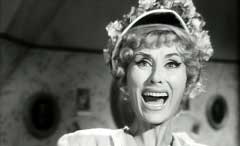
The film can be viewed with reasonably clean uncompressed LPCM 2.0 French or English mono tracks (Vernon dubs himself on both) – the French track offers a better rendering of the experimental score, though – with optional English subtitles, as well as with an audio commentary by Video Watchdog’s Tim Lucas. He traces the lineage of the Orlof name from this film through Franco’s many other unrelated films – as well as Santos Alcocer’s ONLY A COFFIN and Pierre Chevalier’s ORLOFF AND THE INVISIBLE MAN – up through EL SINIESTRO DR. ORLOFF (1984) and FACELESS (1987), as well as the various Tanner (including Franco’s nosey writer in EUGENIE DE SADE) and Malou (including the more astute college-educated junior partner of the lead investigator in Franco’s EXORCISM) characters. He describes Lorys’ Wanda as one of Franco’s strong heroines, and reassessment of the film’s plotting suggests that Tanner’s dismissal of clues and slowness to investigate are more failures of character than plot contrivances to ratchet up tension (especially since the rote finale mostly resolves itself with little involvement from Tanner other than a well-placed bullet).
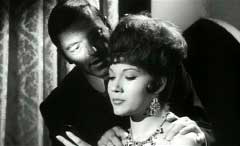 Lucas
also points out the many plot similarities between AWFUL DR. ORLOF and Franco’s
telling of JACK THE RIPPER (1976) for German producer Erwin C. Dietrich (which
also reveals late in the film that Kinski’s character’s name is
Dr. Henry Orlof). He relates that Franco has denied being aware of the film’s
debt to EYES WITHOUT A FACE, but also intriguingly suggests that Franco’s
assertion that the idea to do a horror film came from attending a screening
of Hammer’s BRIDES OF DRACULA with producers Sergio Newman and Marius
Lasoeur was actually a sleight of hand to distract us from the aforementioned
similarities to Alfred Vohrer’s THE DEAD EYES OF LONDON (1961). He also
cites the ways that ORLOF may owe a debt to the earlier “Dark Eyes”
adaptation THE HUMAN MONSTER (1939) as well as Robert Flory’s THE MURDERS
IN THE RUE MORGUE (1932), as well as visual homages to Franco’s favorite
directors Orson Welles and John Brahms, and the comic strip art Franco grew
up devouring (which influenced the casting of Manuel Vázquez Gallego
as the sketch artist).
Lucas
also points out the many plot similarities between AWFUL DR. ORLOF and Franco’s
telling of JACK THE RIPPER (1976) for German producer Erwin C. Dietrich (which
also reveals late in the film that Kinski’s character’s name is
Dr. Henry Orlof). He relates that Franco has denied being aware of the film’s
debt to EYES WITHOUT A FACE, but also intriguingly suggests that Franco’s
assertion that the idea to do a horror film came from attending a screening
of Hammer’s BRIDES OF DRACULA with producers Sergio Newman and Marius
Lasoeur was actually a sleight of hand to distract us from the aforementioned
similarities to Alfred Vohrer’s THE DEAD EYES OF LONDON (1961). He also
cites the ways that ORLOF may owe a debt to the earlier “Dark Eyes”
adaptation THE HUMAN MONSTER (1939) as well as Robert Flory’s THE MURDERS
IN THE RUE MORGUE (1932), as well as visual homages to Franco’s favorite
directors Orson Welles and John Brahms, and the comic strip art Franco grew
up devouring (which influenced the casting of Manuel Vázquez Gallego
as the sketch artist).
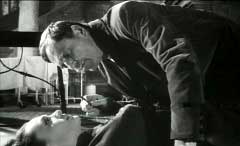
In "The Horror of Orloff" (15:48), Franco – in presumably one of his last interviews – begins by saying that everyone who interviews him wants to talk about THE AWFUL DR. ORLOF. Of the similarities with EYES WITHOUT A FACE, he claims that he and Franju simply came up with similar ideas at the same time (although the Franju film is based on an earlier Jean Redon novel). In discussing the project he meant to make before the Spanish censors intervened, Franco notes that he initially set out to be an intellectual filmmaker along the lines of Michelangelo Antonioni. In Daniel Gouyette’s documentary "The Young Dr. Orloff Chronicles" (18:42), Eurocine’s Daniel Lasoeur – son of ORLOFF co-producer Marius Lasoeur – rehashes the origin story of the project with his father, Franco, and Sergio Newman going to see BRIDES OF DRACULA after the Spanish censors. Critic Lucas Balbo – who co-authored the first English book on Franco “Obsession: The Films of Jess Franco” – discusses the film’s debut to the aforementioned Edgar Wallace adaptations. He also reveals that his “David Khunne” pseudonym is derived from English pulp mystery writer “David K. Hume”, but never cops to the apparent non-existence of any of his own supposed source novels. Writers/collaborators Alain Petit and Jean-Pierre Bouxyou discuss the differences between the French and Spanish versions, their youthful reactions to the onscreen displays of nudity, and illustrate how the continuity suffered with the inserts. Petit also reveals that the original shot of Vernon bringing the scalpel up to Laso’s face (rather than her chest) was rediscovered amidst the “flashback” footage used for REVENGE IN THE HOUSE OF USHER (and that shot is illustrated here presumably from the Eurocine master for REVENGE).
The “Homage to Jess Franco” (8:24) is the same piece featured on the new Redemption discs of A VIRGIN AMONG THE LIVING DEAD and NIGHTMARES COME AT NIGHT in which Franco collaborators and critics muse on what the recently departed director is doing on another plane of existence. A still gallery is also included as well as the campy American trailer (1:37) “In Funereal Black and White”. The disc also includes trailers for A VIRGIN AMONG THE LIVING DEAD, FEMALE VAMPIRE, EXORCISM/DEMONIAC, and OASIS OF THE ZOMBIES. (Eric Cotenas)